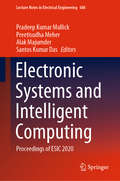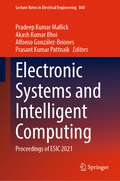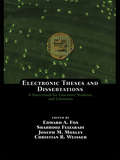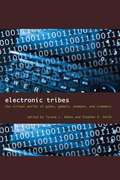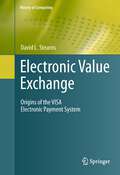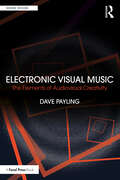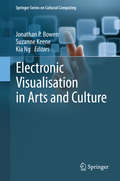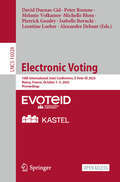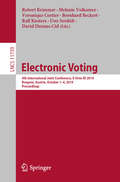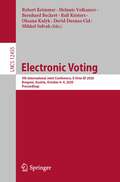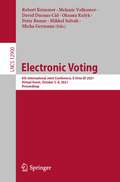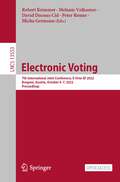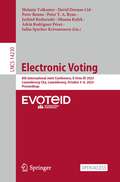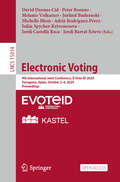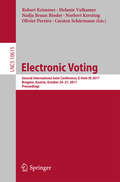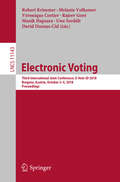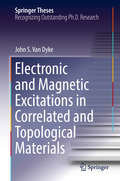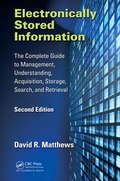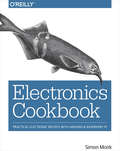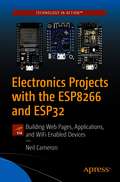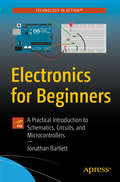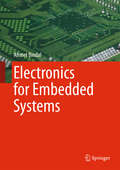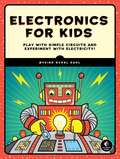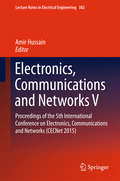- Table View
- List View
Electronic Systems and Intelligent Computing: Proceedings of ESIC 2020 (Lecture Notes in Electrical Engineering #686)
by Pradeep Kumar Mallick Preetisudha Meher Alak Majumder Santos Kumar DasThis book presents selected, high-quality research papers from the International Conference on Electronic Systems and Intelligent Computing (ESIC 2020), held at NIT Yupia, Arunachal Pradesh, India, on 2 – 4 March 2020. Discussing the latest challenges and solutions in the field of smart computing, cyber-physical systems and intelligent technologies, it includes papers based on original theoretical, practical and experimental simulations, developments, applications, measurements, and testing. The applications and solutions featured provide valuable reference material for future product development.
Electronic Systems and Intelligent Computing: Proceedings of ESIC 2021 (Lecture Notes in Electrical Engineering #860)
by Prasant Kumar Pattnaik Akash Kumar Bhoi Pradeep Kumar Mallick Alfonso González-BrionesThis book is a compilation of contributed research work from International Conference on Electronic Systems and Intelligent Computing (ESIC 2021) and covers the areas of electronics, communication, electrical and computing. This book is specifically targeted to the students, research scholars and academician from the background of electronics, communication, electrical and computer science. Advances in electronics, communication, electrical and computing cover the different approaches and techniques for specific applications using particle swarm optimization, Otsu’s function and harmony search optimization algorithm, DNA-NAND gate, triple gate SOI MOSFET, micro-Raman and FTIR analysis, high-k dielectric gate oxide, spectrum sensing in cognitive radio, microstrip antenna, GPR with conducting surfaces, energy-efficient packet routing, iBGP route reflectors, circularly polarized antenna, double fork-shaped patch radiator, implementation of Doppler radar at 24 GHz, iris image classification using SVM, digital image forgery detection, secure communication, spoken dialog system and DFT-DCT spreading strategies.
Electronic Textual Editing
by John Unsworth Lou Burnard Katherine O'Brien O'KeeffeAlthough the contributors come from diverse disciplines and institutions around the world, this collection reflects an emerging consensus about the fundamental issues of electronic textual editing. The 24 essays address markup coding and procedures, electronic archive administration, use of standards, rights and permissions, and the changing environment of the internet. The guidelines of the Modern Language Association for scholarly editions are included in full.
Electronic Theses and Dissertations: A Sourcebook for Educators: Students, and Librarians (Books In Library And Information Science Ser. #Vol. 65)
by Christian R. Weisser Joseph M. Moxley Edward A.Fox Shahrooz FeizabadiElectronic Theses and Dissertations examines how electronic publication of theses and dissertations might enhance graduate education. This text clarifies the composition, evaluation, dissemination, and preservation of electronic theses and dissertations (ETDs), and provides a conceptual framework for the development of effective ETD programs. It id
Electronic Tribes
by Stephen A. Smith Tyrone L. AdamsWhether people want to play games and download music, engage in social networking and professional collaboration, or view pornography and incite terror, the Internet provides myriad opportunities for people who share common interests to find each other. The contributors to this book argue that these self-selected online groups are best understood as tribes, with many of the same ramifications, both positive and negative, that tribalism has in the non-cyber world. In Electronic Tribes, the authors of sixteen competitively selected essays provide an up-to-the-minute look at the social uses and occasional abuses of online communication in the new media era. They explore many current Internet subcultures, including MySpace. com, craftster. org, massively multiplayer online role-playing games (MMORPGs) such as World of Warcraft, music downloading, white supremacist and other counterculture groups, and Nigerian e-mail scams. Their research raises compelling questions and some remarkable answers about the real-life social consequences of participating in electronic tribes. Collectively, the contributors to this book capture a profound shift in the way people connect, as communities formed by geographical proximity are giving way to communities - both online and offline - formed around ideas.
Electronic Value Exchange
by David L. StearnsElectronic Value Exchange examines in detail the transformation of the VISA electronic payment system from a collection of non-integrated, localized, paper-based bank credit card programs into the cooperative, global, electronic value exchange network it is today. Topics and features: provides a history of the VISA system from the mid-1960s to the early 1980s; presents a historical narrative based on research gathered from personal documents and interviews with key actors; investigates, for the first time, both the technological and social infrastructures necessary for the VISA system to operate; supplies a detailed case study, highlighting the mutual shaping of technology and social relations, and the influence that earlier information processing practices have on the way firms adopt computers and telecommunications; examines how "gateways" in transactional networks can reinforce or undermine established social boundaries, and reviews the establishment of trust in new payment devices.
Electronic Visual Music: The Elements of Audiovisual Creativity (Sound Design)
by Dave PaylingElectronic Visual Music is a comprehensive guide to the composition and performance of visual music, and an essential text for those wanting to explore the history, current practice, performance strategies, compositional methodologies and practical techniques for conceiving and creating electronic visual music. Beginning with historical perspectives to inspire the reader to work creatively and develop their own individual style, visual music theory is then discussed in an accessible form, providing a series of strategies for implementing ideas. Including interviews with current practitioners, Electronic Visual Music provides insight into contemporary working methods and gives a snapshot of the state of the art in this ever-evolving creative discipline. This book is a valuable resource for artists and practitioners, as well as students, educators and researchers working in disciplines such as music composition, music production, video arts, animation and related media arts, who are interested in informing their own work and learning new strategies and techniques for exploration and creative expression of electronic visual music.
Electronic Visualisation in Arts and Culture
by Jonathan P. Bowen Kia Ng Suzanne KeenePresenting the latest technological developments in arts and culture, this volume demonstrates the advantages of a union between art and science. Electronic Visualisation in Arts and Culture is presented in five parts: Imaging and CultureNew Art PracticeSeeing MotionInteraction and Interfaces Visualising HeritageElectronic Visualisation in Arts and Culture explores a variety of new theory and technologies, including devices and techniques for motion capture for music and performance, advanced photographic techniques, computer generated images derived from different sources, game engine software, airflow to capture the motions of bird flight and low-altitude imagery from airborne devices. The international authors of this book are practising experts from universities, art practices and organisations, research centres and independent research. They describe electronic visualisation used for such diverse aspects of culture as airborne imagery, computer generated art based on the autoimmune system, motion capture for music and for sign language, the visualisation of time and the long term preservation of these materials. Selected from the EVA London conferences from 2009-2012, held in association with the Computer Arts Society of the British Computer Society, the authors have reviewed, extended and fully updated their work for this state-of-the-art volume.
Electronic Voting: 10th International Joint Conference, E-Vote-ID 2025, Nancy, France, October 1–3, 2025, Proceedings (Lecture Notes in Computer Science #16028)
by Melanie Volkamer David Duenas-Cid Isabelle Borucki Peter Roenne Michelle Blom Pierrick Gaudry Leontine Loeber Alexandre DebantThis open access book constitutes the proceedings of the 10th International Joint Conference on Electronic Voting, E-Vote-ID 2024, held in Nancy, France, during October 1-3, 2025. The 13 full papers included in this book were carefully reviewed and selected from 39 submissions. They focus on on the development of Electronic and Internet Voting and Electoral Technologies, from aspects relating to security and usability to practical experiences and applications of voting systems, also including legal, social, or political aspects, amongst others, turning out to be an important global reference point concerning these issues.
Electronic Voting: 4th International Joint Conference, E-Vote-ID 2019, Bregenz, Austria, October 1–4, 2019, Proceedings (Lecture Notes in Computer Science #11759)
by Robert Krimmer Melanie Volkamer Ralf Küsters Uwe Serdült David Duenas-Cid Bernhard Beckert Veronique CortierThis book constitutes the proceedings of the 4th International Conference on Electronic Voting, E-Vote-ID 2019, held in Bregenz, Austria, in October 2019. The 13 revised full papers presented were carefully reviewed and selected from 45 submissions. The conference was organized in tracks on security, usability and technical issues, administrative, legal, political and social issues, elections and practical experiences, posters and e-voting system demo.
Electronic Voting: 5th International Joint Conference, E-Vote-ID 2020, Bregenz, Austria, October 6–9, 2020, Proceedings (Lecture Notes in Computer Science #12455)
by Robert Krimmer Melanie Volkamer Ralf Küsters David Duenas-Cid Bernhard Beckert Oksana Kulyk Mikhel SolvakThis book constitutes the proceedings of the 5th International Conference on Electronic Voting, E-Vote-ID 2020, held online -due to COVID -19- in Bregenz, Austria, in October 2020. The 14 full papers presented were carefully reviewed and selected from 55 submissions.The conference collected the most relevant debates on the development of Electronic Voting, from aspects relating to security and usability through to practical experiences and applications of voting systems, also including legal, social or political aspects, amongst others; turning out to be an important global referent in relation to this issue.
Electronic Voting: 6th International Joint Conference, E-Vote-ID 2021, Virtual Event, October 5–8, 2021, Proceedings (Lecture Notes in Computer Science #12900)
by Robert Krimmer Melanie Volkamer David Duenas-Cid Oksana Kulyk Peter Rønne Mihkel Solvak Micha GermannThis book constitutes the proceedings of the 6th International Conference on Electronic Voting, E-Vote-ID 2021, held online -due to COVID -19- in Bregenz, Austria, in October 2021. The 14 full papers presented were carefully reviewed and selected from 55 submissions. The conference collected the most relevant debates on the development of Electronic Voting, from aspects relating to security and usability through to practical experiences and applications of voting systems, as well as legal, social or political aspects.
Electronic Voting: 7th International Joint Conference, E-Vote-ID 2022, Bregenz, Austria, October 4–7, 2022, Proceedings (Lecture Notes in Computer Science #13553)
by Robert Krimmer Melanie Volkamer David Duenas-Cid Peter Rønne Micha GermannThis open access book LNCS 13353 constitutes the proceedings of the 7th International Conference on Electronic Voting, E-Vote-ID 2022, held in Bregenz, Austria, in October 2022. The 10 full papers presented were carefully reviewed and selected from 39 submissions. The conference collected the most relevant debates on the development of Electronic Voting, from aspects relating to security and usability through to practical experiences and applications of voting systems, also including legal, social, or political aspects, amongst others.
Electronic Voting: 8th International Joint Conference, E-Vote-ID 2023, Luxembourg City, Luxembourg, October 3–6, 2023, Proceedings (Lecture Notes in Computer Science #14230)
by Peter Y. A. Ryan Melanie Volkamer David Duenas-Cid Oksana Kulyk Peter Rønne Jurlind Budurushi Adrià Rodriguez Pérez Iuliia Spycher-KrivonosovaThis open access book constitutes the proceedings of the 8th International Joint Conference on Electronic Voting held in Luxemburg in October 2023. The conference collected the most relevant debates on the development of Electronic Voting, from aspects relating to security and usability through to practical experiences and applications of voting systems, also including legal, social, or political aspects, amongst others. The 9 full papers presented were carefully reviewed and selected from 38 submissions. The selected papers cover a wide range of topics connected with electronic voting, including experiences and revisions of the actual uses of E-voting systems and corresponding processes in elections.
Electronic Voting: 9th International Joint Conference, E-Vote-ID 2024, Tarragona, Spain, October 2–4, 2024, Proceedings (Lecture Notes in Computer Science #15014)
by Melanie Volkamer David Duenas-Cid Jurlind Budurushi Iuliia Spycher-Krivonosova Peter Roenne Michelle Blom Adrià Rodríguez-Pérez Jordi Castellà Roca Jordi Barrat EsteveThis open access book constitutes the proceedings of the 9th International Joint Conference on Electronic Voting, E-Vote-ID 2024, held in Tarragona, Spain, during October 2-4, 2024. The 10 full papers included in this book were carefully reviewed and selected from 36 submissions. They present research on all aspects of the mechanization of reasoning with tableaux and related methods. The papers cover a wide range of topics connected with electronic voting, including experiences and revisions of the actual uses of E-voting systems and corresponding processes in elections.
Electronic Voting: Second International Joint Conference, E-Vote-ID 2017, Bregenz, Austria, October 24-27, 2017, Proceedings (Lecture Notes in Computer Science #10615)
by Robert Krimmer, Melanie Volkamer, Nadja Braun Binder, Norbert Kersting, Olivier Pereira and Carsten SchürmannThis book constitutes the refereed proceedings of the Second International Joint Conference on Electronic Voting, E-Vote-ID 2017, held in Bregenz, Austria, in October 2017.The 16 full papers presented in this volume were carefully reviewed and selected from 48 submissions. In addition the book contains 3 keynote talks. The papers deal with security, usability and technical issues; administrative, legal, political and social issued; and election and practical experiences.
Electronic Voting: Third International Joint Conference, E-Vote-ID 2018, Bregenz, Austria, October 2-5, 2018, Proceedings (Lecture Notes in Computer Science #11143)
by Robert Krimmer Melanie Volkamer Véronique Cortier Rajeev Goré Manik Hapsara Uwe Serdült David Duenas-CidThis book constitutes the refereed proceedings of the Third International Joint Conference on Electronic Voting, E-Vote-ID 2018, held in Bregenz, Austria, in October 2018. The 13 full papers presented in this volume were carefully reviewed and selected from 45 submissions. The papers deal with topics connected with electronic voting including experiences and revisions of the real uses of E-voting systems and corresponding processes in elections.
Electronic and Magnetic Excitations in Correlated and Topological Materials (Springer Theses)
by John S. Van DykeThis thesis reports a major breakthrough in discovering the superconducting mechanism in CeCoIn5, the “hydrogen atom” among heavy fermion compounds. By developing a novel theoretical formalism, the study described herein succeeded in extracting the crucial missing element of superconducting pairing interaction from scanning tunneling spectroscopy experiments. This breakthrough provides a theoretical explanation for a series of puzzling experimental observations, demonstrating that strong magnetic interactions provide the quantum glue for unconventional superconductivity. Additional insight into the complex properties of strongly correlated and topological materials was provided by investigating their non-equilibrium charge and spin transport properties. The findings demonstrate that the interplay of magnetism and disorder with strong correlations or topology leads to complex and novel behavior that can be exploited to create the next generation of spin electronics and quantum computing devices.
Electronically Stored Information: The Complete Guide to Management, Understanding, Acquisition, Storage, Search, and Retrieval
by David MatthewsAlthough we live in an era in which we are surrounded by an ever-deepening fog of data, few of us truly understand how the data are created, where data are stored, or how to retrieve or destroy data—if that is indeed possible. This book is for all of you, whatever your need or interest. <p><P>Electronically Stored Information: The Complete Guide to Management, Understanding, Acquisition, Storage, Search, and Retrieval, Second Edition explains the reasons you need to know about electronic data. It also gets into great detail about the how, what, when, and where of what is known in legal circles as electronically stored information (ESI). <p><P>With easy-to-understand explanations and guidelines, this book provides the practical understanding you need to effectively manage the complex world of ESI. Whether you are an attorney, judge, paralegal, business manager or owner, or just one of the ever-growing population of computer users, you will benefit from the information presented in this book.
Electronics Cookbook: Practical Electronic Recipes with Arduino and Raspberry Pi
by Simon MonkIf you’re among the many hobbyists and designers who came to electronics through Arduino and Raspberry Pi, this cookbook will help you learn and apply the basics of electrical engineering without the need for an EE degree. Through a series of practical recipes, you’ll learn how to solve specific problems while diving into as much or as little theory as you’re comfortable with.Author Simon Monk (Raspberry Pi Cookbook) breaks down this complex subject into several topics, from using the right transistor to building and testing projects and prototypes. With this book, you can quickly search electronics topics and go straight to the recipe you need. It also serves as an ideal reference for experienced electronics makers.This cookbook includes:Theoretical concepts such as Ohm’s law and the relationship between power, voltage, and currentThe fundamental use of resistors, capacitors and inductors, diodes, transistors and integrated circuits, and switches and relaysRecipes on power, sensors and motors, integrated circuits, and radio frequency for designing electronic circuits and devicesAdvice on using Arduino and Raspberry Pi in electronics projectsHow to build and use tools, including multimeters, oscilloscopes, simulations software, and unsoldered prototypes
Electronics Projects with the ESP8266 and ESP32: Building Web Pages, Applications, and WiFi Enabled Devices
by Neil CameronDiscover the powerful ESP8266 and ESP32 microcontrollers and their Wi-Fi communication. The ESP32 microcontroller features Bluetooth and BLE communication in addition to Wi-Fi. The book emphasizes practical projects and readers are guided through Wi-Fi and Bluetooth communication, mobile app design and build, ESP-NOW and LoRa communication, and signal generation. Projects throughout the book utilize the Wi-Fi functionality and processing power of the ESP microcontrollers. Projects are built in the Arduino IDE, so you don't need to download other programming software. Mobile apps are now ubiquitous, making the app build projects of the book very relevant, as are the web page design projects. In Electronics Projects with the ESP8266 and ESP32, you'll see how easy and practical it is to access information over the internet, develop web pages, build mobile apps to remotely control devices with speech recognition or incorporate Google Maps in a GPS route tracking app. You will · Build practical electronics projects with an ESP8266 or ESP32 microcontroller with Wi-Fi communication · Use the Wi-Fi function of the ESP8266 and ESP32 to update web pages · Communicate with your mobile phone or smart watch by Bluetooth Low Energy · Transmit and receive information to control remote devices over the internet · Understand the design and build of mobile apps for internet based applications · Apply your computer programming skills in C++, JavaScript, AJAX and JSON · Use WebSocket, MQTT brokers and IFTTT for fast two-way communication with webpagesWho This Book Is ForThe target audience is for Makers and Tinkerers who want to build internet/intranet based applications with more powerful microcontrollers, such as the ESP8266 or ESP32. A level of C++ programming expertise with the Arduino IDE is assumed, although all sketches are fully described and comprehensively commented.
Electronics for Beginners: A Practical Introduction to Schematics, Circuits, and Microcontrollers
by Jonathan BartlettJump start your journey with electronics! If you’ve thought about getting into electronics, but don’t know where to start, this book gives you the information you need. Starting with the basics of electricity and circuits, you'll be introduced to digital electronics and microcontrollers, capacitors and inductors, and amplification circuits – all while gaining the basic tools and information you need to start working with low-power electronics.Electronics for Beginners walks the fine line of focusing on projects-based learning, while still keeping electronics front and center. You'll learn the mathematics of circuits in an uncomplicated fashion and see how schematics map on to actual breadboards. Written for the absolute beginner, this book steers clear of being too math heavy, giving readers the key information they need to get started on their electronics journey.What You’ll LearnReview the basic “patterns” of resistor usage—pull up, pull down, voltage divider, and current limiterUnderstand the requirements for circuits and how they are put togetherRead and differentiate what various parts of the schematics doDecide what considerations to take when choosing componentsUse all battery-powered circuits, so projects are safeWho This Book Is ForMakers, students, and beginners of any age interested in getting started with electronics.
Electronics for Embedded Systems
by Ahmet BindalThis book provides semester-length coverage of electronics for embedded systems, covering most common analog and digital circuit-related issues encountered while designing embedded system hardware. It is written for students and young professionals who have basic circuit theory background and want to learn more about passive circuits, diode and bipolar transistor circuits, the state-of-the-art CMOS logic family and its interface with older logic families such as TTL, sensors and sensor physics, operational amplifier circuits to condition sensor signals, data converters and various circuits used in electro-mechanical device control in embedded systems. The book also provides numerous hardware design examples by integrating the topics learned in earlier chapters. The last chapter extensively reviews the combinational and sequential logic design principles to be able to design the digital part of embedded system hardware.
Electronics for Kids: Play with Simple Circuits and Experiment with Electricity!
by Oyvind Nydal Dahl<P>Why do the lights in a house turn on when you flip a switch? How does a remote-controlled car move? And what makes lights on TVs and microwaves blink? The technology around you may seem like magic, but most of it wouldn’t run without electricity.Electronics for Kids demystifies electricity with a collection of awesome hands-on projects. <P>In Part 1, you’ll learn how current, voltage, and circuits work by making a battery out of a lemon, turning a metal bolt into an electromagnet, and transforming a paper cup and some magnets into a spinning motor. <P> In Part 2, you’ll make even more cool stuff as you: <br>–Solder a blinking LED circuit with resistors, capacitors, and relays <br>–Turn a circuit into a touch sensor using your finger as a resistor–Build an alarm clock triggered by the sunrise <br>–Create a musical instrument that makes sci-fi sounds. <P>Then, in Part 3, you’ll learn about digital electronics—things like logic gates and memory circuits—as you make a secret code checker and an electronic coin flipper. Finally, you’ll use everything you’ve learned to make the LED Reaction Game—test your reaction time as you try to catch a blinking light!With its clear explanations and assortment of hands-on projects, Electronics for Kids will have you building your own circuits in no time.
Electronics, Communications and Networks V
by Amir HussainThis book comprises peer-reviewed contributions presented at the 5th International Conference on Electronics, Communications and Networks (CECNet 2015), held in Shanghai, China, 12-15 December, 2015. It includes new multi-disciplinary topics spanning a unique depth and breadth of cutting-edge research areas in Electronic Engineering, Communications and Networks, and Computer Technology. More generally, it is of interest to academics, students and professionals involved in Consumer Electronics Technology, Communication Engineering and Technology, Wireless Communication Systems and Technology, and Computer Engineering and Technology.
